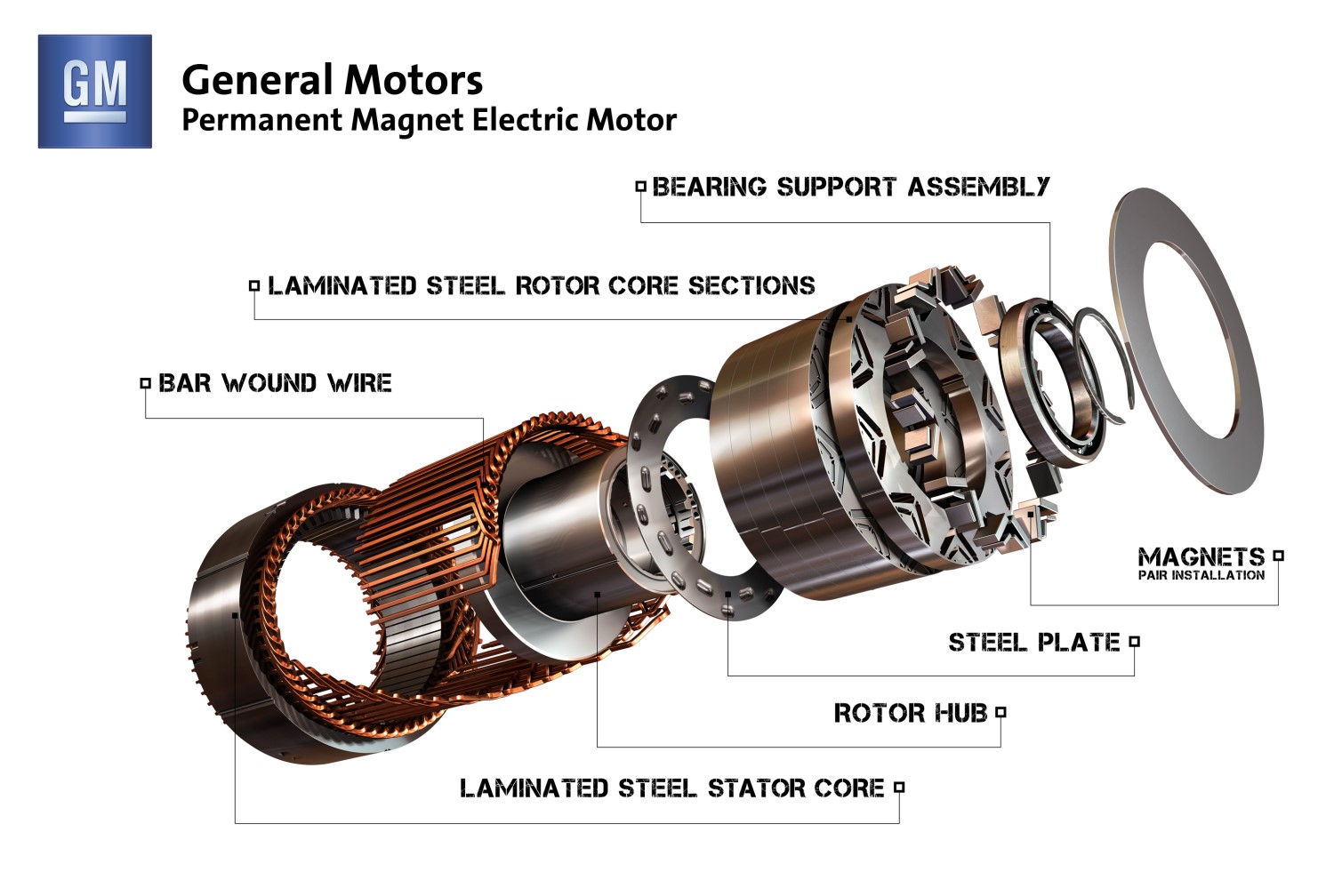Better come up to speed on your electric motor vocabulary
 |
| One of Chevy's electric motors |
Internal combustion engines have been around for about 140 years. In that time, we’ve become fully versed in all their nuances writes Eric Adams of The Drive.
We can chat with our pals about compression ratios and horsepower and valve timing. We know the advantages of displacement and the efficiency of turbos. Car meets quickly turn into oceans of popped hoods. Even the most cutting-edge engine tech in the latest hypercar is parsed out thoroughly in the automotive media. We know engines. We talk engines. We love engines.
We don’t love motors, though–the electric ones, that is. You know, the ones that have been around for almost 250 years and were powering cars in the 1880s, until gasoline engines overtook them due to their range and speedy refueling. (One of the first alternating-current induction motor inventors: Nikola Tesla.) Our collective and virtually absolute lack of knowledge of what actually drives the wheels of all the new electric vehicles on the roads today is, indeed, puzzling. How bad is this problem? Most EV owners probably don’t even know where the motors are in their cars, or how many there are, or what they look like.
Making things worse: Technical information is scarce, and mostly found only in forums and niche technology sites. Consider, as well, the fact that our own Alex Roy just reviewed the brand-new Tesla Model 3, and in the course of 4,000 carefully-crafted words, didn’t mention the motor once.
Not that you could blame him: The Tesla Motors page on the Model 3, which includes a “specs" section, itself makes no mention whatsoever of the motor. Furthermore, the company’s own application to the EPA last year for the car’s Certificate of Conformity dedicated 250 words to describing the battery, but just 20 to the motor. (It’s a “3-phase, 6-pole AC internal permanent-magnet motor" producing 258 hp–or 192 kW–and 317 lb-ft of torque, in case you were wondering.) Similarly, Chevrolet’s page on its new Bolt EV makes no reference to the motor except to say that the car has an “electric drive unit." Even BMW–a company that literally has "motor" for a middle name–only deigns to reveal on its i3 product page that the motor is “AC synchronous."
Meanwhile, the engine in the base-model 3 Series a few clicks over is described as a “2.0-liter BMW TwinPower Turbo inline 4-cylinder, 16-valve 180-hp engine that combines a twin-scroll turbocharger with variable valve control (Double-VANOS and Valvetronic) and high-precision direct injection." That's before the site goes on to describe the engine’s electronic throttle control, auto start-stop function, direct ignition system with knock control, electronically controlled engine cooling (map cooling), brake energy regeneration, and driving dynamics control with Eco Pro, Comfort, and Sport settings.
Among reviewers, Roy is far from the only one to give the motor short shrift. Most EV reviews gloss over that key part of the tech, except to note its relative quiet, its torquey response, and its simplicity and long-term low maintenance requirements. Most of the space dedicated to the powertrain focuses instead on the battery–how big, its construction and composition, where it sits, how much range it has, how many days it takes to fully charge, and so forth.
But then, it's hard to blame people for not giving a damn. Most consumers–hell, even car geeks–don’t possess the knowledge or vocabulary to authoritatively converse about electric motors, and on the surface, there would seem to be precious little indication that there’s even anything meaningful to discuss about them. It’s a lot harder to get excited about, say, the difference between permanent magnets and AC induction than it is between V-8s and twin-turbo sixes. The fact that carmakers and the media don’t billboard motor innovation naturally leads the public to assume that there’s nothing much going on there.
Except…that’s just not true.
While the electric motor has its own century of progress under its belt, there’s still much that can be done. Consider, for one thing, that most carmakers have brought motor manufacturing in-house. If there weren’t room for innovation, they’d just order them out of a catalog from external suppliers. Lighter materials in motor construction, new alternative solutions for rare-earth magnets, and optimized overall performance characteristics for different vehicle demands are all very much in the crosshairs of automotive engineers. And that’s just the start, says Venkat Viswanathan, a mechanical engineering professor at Carnegie Mellon University who studies EV performance.
“The motor efficiency map–that is, its efficiency as a function of torque and speed–determines the energy consumption for consumer vehicles, and the peak power characteristics are an important factor for high-performance demands," Viswanathan said. “In addition, the heating of the motors in-use–at high speeds–is another area with room for innovation and development."
Once you dig in a bit, it becomes clear how much of said optimization and development is really going on. One of the key choices is the general type of the motor. “Typically, most of the manufacturers use synchronous motors, but whether it is a permanent magnet or electromagnet strongly influences the performance," said Viswanathan.
Tesla, for instance, while typically very tight-lipped about its innovation, made a significant change with its Model 3 in its decision to use a permanent-magnet electric motor instead of the AC induction motor it has used so far. The key difference is that AC induction motors have to use electricity to generate the magnetic currents inside the motor, which cause the rotor to spin, whereas a permanent magnet motor doesn’t require that additional current since its magnets–created from rare-earth materials–are always “on."
This all means that the Model 3’s motor is more efficient and thus better for smaller and lighter cars, but not ideal for high-performance cars, since an AC induction motor can produce greater power. The Chevy Bolt uses a similar strategy for the same reason. Eric Adams/The Drive
